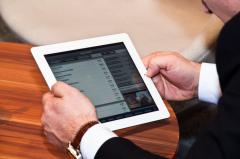
Apple's (NASDAQ: AAPL) recent slide from stratospheric heights has reminded ETF investors of the dangers of owning funds that are excessively weighted to just one or two stocks.
The risks of too much Apple have been previously well-documented and the scenario is arguably as simple as this: Large weights in any ETF to a small number of stocks work...until they do not.
Everything smells like roses for an ETF or mutual fund with substantial Apple exposure as long as the stock keeps going up. Obviously, that has not been the case in recent months as Apple has plunged from about $702 on September 19, 2012 to just over $506 at Wednesday's close.
That tumble has had a predictable impact on some noteworthy ETFs that benefited from Apple's run to unprecedented heights last year. Not including Wednesday's gains, the iShares Dow Jones U.S. Technology Sector Index Fund (NYSE: IYW) has slid 8.6 percent since Apple topped $700 on September 19. IYW, which has $1.54 billion in assets under management, has the largest allocation to Apple of any ETF at 19.1 percent.
The Technology Select Sector SPDR (NYSE: XLK), which currently features a 15.94 percent weight to Apple, is off 7.7 percent since September 19 while the PowerShares QQQ (NASDAQ: QQQ) has shed just under six percent. Commonly referred to as the Nasdaq 100 tracking ETF, QQQ now has a weight of 14.6 to the iPad maker.
All is not lost for investors looking to maintain or initiate positions in the technology sector even as Apple struggles to regain its lost luster. Something else that has been previously highlighted is the utility of equal-weight technology sector ETFs in the face of large Apple declines.
That trend has repeated itself during Apple's plunge from $700. Take the case of the Guggenheim S&P 500 Equal Weight Technology ETF (NYSE: RYT). Apple accounts for just 1.29 percent of that fund's weight. Putting allocation into context, at 1.31 percent of RYT, First Solar (NASDAQ: FSLR) is a larger part of the ETF's lineup than Apple.
RYT is up just 1.1 percent since September 19, but that is far better than what XLK and friends have offered. Here is another factoid that is vital to note: In the past year, XLK is up 11.5 percent, while RYT is up 11.1 percent, indicating that investors did not sacrifice much by skimping on Apple exposure.
Then there is the case of the First Trust NASDAQ-100 Equal Weighted Index (NASDAQ: QQEW), which is an equal-weight answer to QQQ. Apple represents just 0.93 percent of that ETF's weight. Said another way, Whole Foods (NASDAQ: WFM) and Monster Beverage (NASDAQ: MNST) are slightly bigger components in QQEW than Apple.
Hardly any Apple has meant a 2.8 gain for QQEW since September 19, and QQEW is up 12.5 percent in the past year. Obviously, that is better than XLK. That performance also means that despite a weight to Apple that is hundreds of times larger than QQEW's, QQQ could only outperform its equal-weight rival by 100 basis points over the past year.
The point here is not to debate the bull case, or lack thereof, for shares of Apple. Analysts, pundits and owners of the stock can do that. What is important to note is that because of Apple's still lofty price tag, many investors use ETFs to gain exposure to the stock. A lot of those investors know about QQQ, XLK and friends, but they may not know about the merits of RYT, QQEW and related fare. Perhaps that is what the Apple/ETF conversation should be about now.
For more on ETFs, click here.
(c) 2013 Benzinga.com. Benzinga does not provide investment advice. All rights reserved.
Posted in: Long Ideas, News, Sector ETFs, Broad U.S. Equity ETFs, Short Ideas, Specialty ETFs, After-Hours Center, Markets, Movers, Tech, Trading Ideas, ETFs, Best of Benzinga
Advertisement?
Heptathlon London 2012 shot put London 2012 Track And Field Jordyn Wieber michael phelps Kerri Strug Ledecky
No comments:
Post a Comment
Note: Only a member of this blog may post a comment.